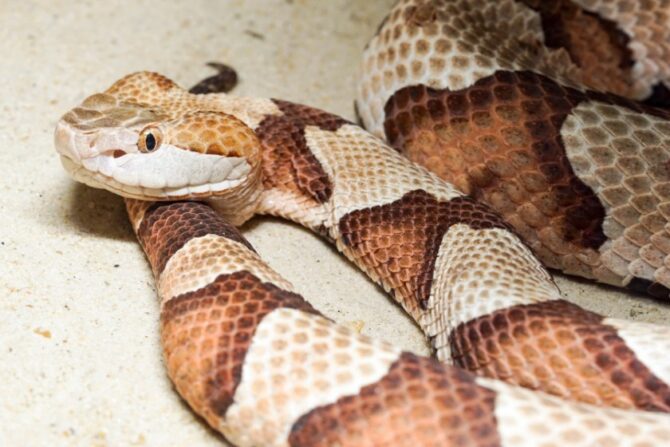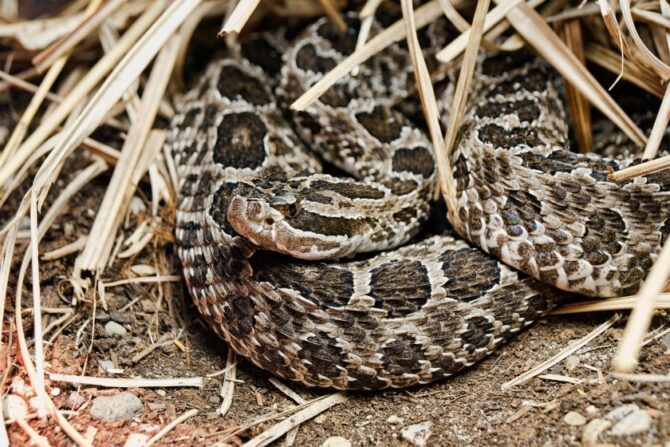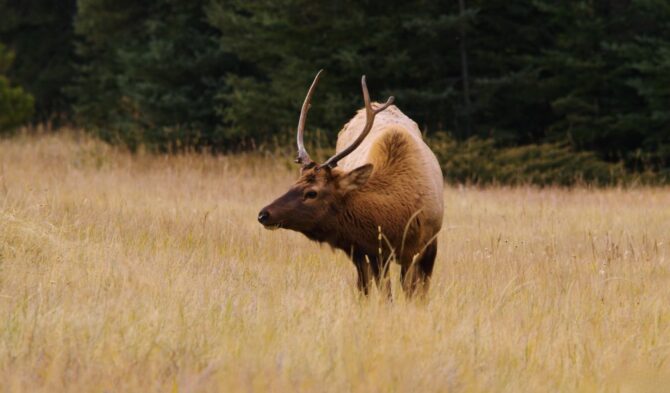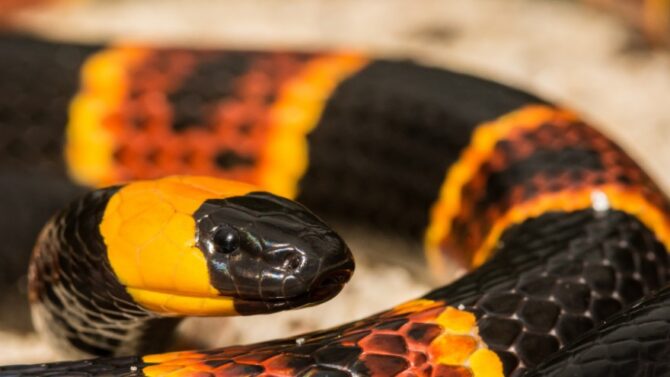Pennsylvania is a landlocked state in the Mid-Atlantic, northeast region of the United States.
It has farmlands, mountains, forests, and diverse animal species, many of which are snakes.
There are about 21 species of snakes in Pennsylvania, but only three are venomous.
The three venomous snakes in Pennsylvania are the copperhead, the eastern massasauga rattlesnake, and the timber rattlesnake.
This article sheds more light on these snakes, their habitat, and how to identify them. Read on to find out more.
3 Venomous Snakes in Pennsylvania
1. Copperhead

- Scientific Name: Agkistrodon contortrix
- Size: 24 to 36 inches
- Habitat: Wood piles, forest, rocky outcrops, wooded hillsides
- Identifying Features: Thick body, hourglass-shaped bands across its body, large triangular heads, and elliptical pupils (cat eyes)
- Behavior: Defensive tail vibration, moderately shy, and solitary
- Threats to Humans: Extreme pain, tingling sensation, throbbing, swelling, nausea, vomiting, and, in extreme cases, death
Copperheads are the most common venomous snakes in every region in Pennsylvania.
They are excellent when it comes to camouflage, usually blending with debris and leaves.
These snakes have thick, heavy bodies, with large angular heads and cat-like eyes.
They are generally not aggressive, except when disturbed or stepped on.
Copperheads are nocturnal when the heat becomes extreme in summer, but they are usually active when the temperature is mild.
When hibernating, copperheads usually nest in dens with other copperheads and other species of snakes, including timber rattlesnakes and black rat snakes.1
They tend to return to the same den to hibernate every year.
While their bites aren’t always lethal, copperheads are still dangerous to be around.
When bitten by this snake, the victim may experience severe pain, nausea, and swelling.
Fortunately, it’s not hard to stay safe from copperheads.
Simply be mindful of your environment and retreat quietly if you suddenly encounter a copperhead.
2. Eastern Massasauga Rattlesnake

- Scientific Name: Sistrurus catenatus
- Size: 18 to 36 inches
- Habitat: Wetlands, wet grasslands, upland, marshy areas, and woodlands
- Identifying Features: Small thick bodies, triangular- or heart-shaped heads, vertical pupils, small rattle, and brown color with black or brown blotches
- Behavior: Timid, secretive, motionless in the face of perceived predators, not prone to strike
- Threat to Humans: Severe pain, bleeding, redness, skin discoloration, swelling, and difficulty breathing
The eastern massasauga is a rattlesnake species in Pennsylvania. It is currently considered to be monotypic (i.e., it has no recognized subspecies).
Eastern massasaugas are small, timid, and secretive snakes, preferring to hide or withdraw from their predators (especially humans) instead of striking them.
They also have a rattle, but it’s rarely heard because it is small, quiet, and only used occasionally.
During winter, eastern massasaugas hibernate alone in crayfish burrows or burrows made by other animals, and in summer, they find warm spots to bask in the heat.
The venom of the eastern massasauga is cytotoxic—it’s highly toxic to cells.2
However, the fatality rates of their bites are low because the species have short fangs that can only inject a small amount of venom at a time.
Nevertheless, their bites are still dangerous.
Symptoms of their venom include severe pain, tissue damage, bleeding, redness, swelling, shortness of breath, and, in extreme cases, death.
Children and sick people are at a higher risk of experiencing the worst effects of a bite from the eastern massasauga.
3. Timber Rattlesnakes

- Scientific Name: Crotalus horridus
- Size: 36 to 60 inches
- Habitat: Upland forests, lowlands, wetlands, dens, thick bushes, farms, deciduous forests, mountains
- Identifying Features: Heavy body, rattle, black chevron-shaped crossbands down the body, reddish-brown stripe down the center of the back, brown specks sprinkled across its tan or light gray belly, and black tails
- Behavior: Solitary, camouflages, stays dormant in the den during winter, and vibrates rattle to warn predators
- Threats to Humans: Dangerous bite, severe pain, numbness, internal bleeding, skin darkening, paralysis, cardiac arrest, and even death
Timber rattlesnakes, also known as canebrakes, are the second largest venomous snake in the United States.
This snake species is widely spread throughout Pennsylvania.
Like every other species of rattlesnake, timber rattlesnakes have a prominent rattle at the end of their tail.
They can be found in different abodes, including high areas like crevices of rocky cliffs and mountains.
They also reside around rivers, flood plains, dens in cracks, lowlands, thick bushes, and farms.
Timber rattlesnakes mainly eat small- to medium-sized rodents, like mice, chipmunks, and squirrels. They also eat birds, lizards, and amphibians.
These snakes are generally not aggressive and only bite humans when cornered or mistakenly stepped upon as a defense mechanism.
Their venom contains neurotoxins and hemotoxins, resulting in several symptoms, like external and internal bleeding, cell death, skin darkening, pains and swelling, bruises, numbness, weakness, sweating, salivating, and blurred vision.
Final Thoughts
Staying safe from venomous snakes in Pennsylvania is very easy.
Most venomous snakes avoid humans and will rather use their venom for their prey.
Nevertheless, be mindful of your environment, especially when in the woods or outdoors.
Wearing protective clothing and a sturdy pair of boots is also advised, as it gives you an extra layer of protection from these snakes.
Finally, be especially careful during spring and fall, as those are when venomous snakes are most active.
References & Notes
- Northern Copperhead. Smithsonian’s National Zoo
- Eastern Massasauga. Smithsonian’s National Zoo






